Cookie
A cookie is a baked or cooked food that is typically small, flat and sweet. It usually contains flour, sugar and some type of oil or fat. It may include other ingredients such as raisins, oats, chocolate chips, nuts, etc.
 Chocolate chip cookies | |
| Alternative names | Biscuit |
|---|---|
| Course | Snack, dessert |
| Place of origin | Persia, 7th century AD[1][2] |
| Serving temperature | Often room temperature, although they may be served when still warm from the oven |
In most English-speaking countries except for the United States and Canada, crisp cookies are called biscuits. Chewier biscuits are sometimes called cookies even in the United Kingdom.[3] Some cookies may also be named by their shape, such as date squares or bars.
Biscuit or cookie variants include sandwich biscuits, such as custard creams, Jammie Dodgers, Bourbons and Oreos, with marshmallow or jam filling and sometimes dipped in chocolate or another sweet coating. Cookies are often served with beverages such as milk, coffee or tea and sometimes "dunked", an approach which releases more flavour from confections by dissolving the sugars,[4] while also softening their texture. Factory-made cookies are sold in grocery stores, convenience stores and vending machines. Fresh-baked cookies are sold at bakeries and coffeehouses, with the latter ranging from small business-sized establishments to multinational corporations such as Starbucks.
Terminology
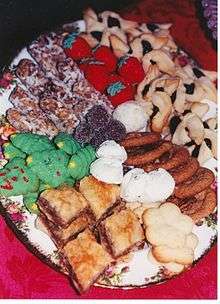
In many English-speaking countries outside North America, including the United Kingdom, the most common word for a crisp cookie is biscuit.[3] The term cookie is normally used to describe chewier ones.[3] However, in many regions both terms are used. The container used to store cookies may be called a cookie jar.
In Scotland the term cookie is sometimes used to describe a plain bun.[5]
Cookies that are baked as a solid layer on a sheet pan and then cut, rather than being baked as individual pieces, are called in British English bar cookies or traybakes.[3]
Etymology
The word dates from 1730, Scottish usage, but the word meant "plain bun," rather than thin baked good, and so it is not certain whether it is the same word. From 1808, the word "cookie" is attested "...in the sense of "small, flat, sweet cake" in American English. The American use is derived from Dutch koekje "little cake," which is a diminutive of "koek" ("cake"), which came from the Middle Dutch word "koke".[6] Another claim is that the American name derives from the Dutch word koekje or more precisely its informal, dialect variant koekie[7] which means little cake, and arrived in American English with the Dutch settlement of New Netherland, in the early 1600s.
According to the Scottish National Dictionary, its Scottish name derives from the diminutive form (+ suffix -ie) of the word cook, giving the Middle Scots cookie, cooky or cu(c)kie. There was much trade and cultural contact across the North Sea between the Low Countries and Scotland during the Middle Ages, which can also be seen in the history of curling and, perhaps, golf.
Description
.jpg)
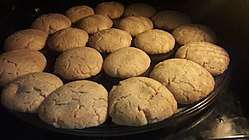
Cookies are most commonly baked until crisp or just long enough that they remain soft, but some kinds of cookies are not baked at all. Cookies are made in a wide variety of styles, using an array of ingredients including sugars, spices, chocolate, butter, peanut butter, nuts, or dried fruits. The softness of the cookie may depend on how long it is baked.
A general theory of cookies may be formulated this way. Despite its descent from cakes and other sweetened breads, the cookie in almost all its forms has abandoned water as a medium for cohesion. Water in cakes serves to make the base (in the case of cakes called "batter"[8]) as thin as possible, which allows the bubbles – responsible for a cake's fluffiness – to better form. In the cookie, the agent of cohesion has become some form of oil. Oils, whether they be in the form of butter, vegetable oils, or lard, are much more viscous than water and evaporate freely at a much higher temperature than water. Thus a cake made with butter or eggs instead of water is far denser after removal from the oven.
Oils in baked cakes do not behave as baking soda tends to in the finished result. Rather than evaporating and thickening the mixture, they remain, saturating the bubbles of escaped gases from what little water there might have been in the eggs, if added, and the carbon dioxide released by heating the baking powder. This saturation produces the most texturally attractive feature of the cookie, and indeed all fried foods: crispness saturated with a moisture (namely oil) that does not sink into it.
History
.jpg)
Cookie-like hard wafers have existed for as long as baking is documented, in part because they deal with travel very well, but they were usually not sweet enough to be considered cookies by modern standards.[9]
Cookies appear to have their origins in 7th century AD Persia, shortly after the use of sugar became relatively common in the region.[10][1] They spread to Europe through the Muslim conquest of Spain. By the 14th century, they were common in all levels of society throughout Europe, from royal cuisine to street vendors.
With global travel becoming widespread at that time, cookies made a natural travel companion, a modernized equivalent of the travel cakes used throughout history. One of the most popular early cookies, which traveled especially well and became known on every continent by similar names, was the jumble, a relatively hard cookie made largely from nuts, sweetener, and water.
Cookies came to America through the Dutch in New Amsterdam in the late 1620s. The Dutch word "koekje" was Anglicized to "cookie" or cooky. The earliest reference to cookies in America is in 1703, when "The Dutch in New York provided...'in 1703...at a funeral 800 cookies...'"[11]
The most common modern cookie, given its style by the creaming of butter and sugar, was not common until the 18th century.[12]
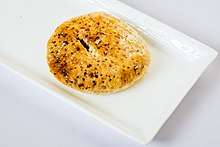
Classification

Cookies are broadly classified according to how they are formed or made, including at least these categories:
- Bar cookies consist of batter or other ingredients that are poured or pressed into a pan (sometimes in multiple layers) and cut into cookie-sized pieces after baking. In British English, bar cookies are known as "tray bakes".[3] Examples include brownies, fruit squares, and bars such as date squares.
- Drop cookies are made from a relatively soft dough that is dropped by spoonfuls onto the baking sheet. During baking, the mounds of dough spread and flatten. Chocolate chip cookies (Toll House cookies), oatmeal raisin (or other oatmeal-based) cookies, and rock cakes are popular examples of drop cookies. This may also include thumbprint cookies, for which a small central depression is created with a thumb or small spoon before baking to contain a filling, such as jam or a chocolate chip.[13] In the UK, the term "cookie" often refers only to this particular type of product.
- Filled cookies are made from a rolled cookie dough filled with a fruit, jam or confectionery filling before baking. Hamantashen are a filled cookie.
- Molded cookies are also made from a stiffer dough that is molded into balls or cookie shapes by hand before baking. Snickerdoodles and peanut butter cookies are examples of molded cookies. Some cookies, such as hermits or biscotti, are molded into large flattened loaves that are later cut into smaller cookies.
- No-bake cookies are made by mixing a filler, such as cereal or nuts, into a melted confectionery binder, shaping into cookies or bars, and allowing to cool or harden. Oatmeal clusters and rum balls are no-bake cookies.
- Pressed cookies are made from a soft dough that is extruded from a cookie press into various decorative shapes before baking. Spritzgebäck is an example of a pressed cookie.
- Refrigerator cookies (also known as icebox cookies) are made from a stiff dough that is refrigerated to make the raw dough even stiffer before cutting and baking. The dough is typically shaped into cylinders which are sliced into round cookies before baking. Pinwheel cookies and those made by Pillsbury are representative.
- Rolled cookies are made from a stiffer dough that is rolled out and cut into shapes with a cookie cutter. Gingerbread men are an example.
- Sandwich cookies are rolled or pressed cookies that are assembled as a sandwich with a sweet filling. Fillings include marshmallow, jam, and icing. The Oreo cookie, made of two chocolate cookies with a vanilla icing filling, is an example.
Other types of cookies are classified for other reasons, such as their ingredients, size, or intended time of serving:
- Breakfast cookies are typically larger, lower-sugar cookies filled with "heart-healthy nuts and fiber-rich oats" that are eaten as a quick breakfast snack.[14]
- Low-fat cookies or diet cookies typically have lower fat than regular cookies.[15]
- Raw cookie dough is served in some restaurants, though the eggs may be omitted since the dough is eaten raw, which could pose a salmonella risk if eggs were used. Cookie Dough Confections in New York City is a restaurant that has a range of raw cookie dough flavors, which are scooped into cups for customers like ice cream.[16]
- Skillet cookies are big cookies that are cooked in a cast-iron skillet and served warm, while they are still soft and chewy. They are either eaten straight from the pan or cut into wedges, often with vanilla ice cream on top.[17]
- Supersized cookies are large cookies such as the Panera Kitchen Sink Cookie.[18] These very large cookies are sold at grocery stores, restaurants and coffeeshops.
- Vegan cookies can be made with flour, sugar, nondairy milk and nondairy margarine. Aquafaba icing can used to decorate the cookies.
- Cookie cakes are made in a larger circular shape usually with writing made of frosting.
Reception
Leah Ettman from Nutrition Action has criticized the high calorie count and fat content of supersized cookies, which are extra large cookies; she cites the Panera Kitchen Sink Cookie, a supersized chocolate chip cookie, which measures 5 1/2 inches in diameter and has 800 calories.[19] For busy people who eat breakfast cookies in the morning, Kate Bratskeir from the Huffington Post recommends lower-sugar cookies filled with "heart-healthy nuts and fiber-rich oats".[20] A book on nutrition by Paul Insel et al notes that "low-fat" or "diet cookies" may have the same number of calories as regular cookies, due to added sugar.[21]
Popular culture
There are a number of slang usages of the term "cookie". The slang use of "cookie" to mean a person, "especially an attractive woman" is attested to in print since 1920.[22] The catchphrase "that's the way the cookie crumbles", which means "that's just the way things happen" is attested to in print in 1955.[23] Other slang terms include "smart cookie” and “tough cookie.” According to The Cambridge International Dictionary of Idioms, a smart cookie is “someone who is clever and good at dealing with difficult situations.” [24] The word "cookie" has been vulgar slang for "vagina" since 1970 in the US.[25] The word "cookies" is used to refer to the contents of the stomach, often in reference to vomiting (e.g., "pop your cookies" a 1960s expression, or "toss your cookies", a 1970s expression).[26] The expression "cookie cutter", in addition to referring literally to a culinary device to rolled cookie dough into shapes, is also used metaphorically to refer to items or things "having the same configuration or look as many others" (e.g., a "cookie cutter tract house") or to label something as "stereotyped or formulaic" (e.g., an action movie filled with "generic cookie cutter characters").[27] "Cookie duster" is a whimsical expression for a mustache.
Cookie Monster is a Muppet on the long-running children's television show Sesame Street who is best known for his voracious appetite for cookies and his famous eating phrases, such as "Me want cookie!", "Me eat cookie!" (or simply "COOKIE!"), and "Om nom nom nom" (said through a mouth full of food).[28][29][30][31]
Notable varieties
- Alfajor
- Angel Wings (Chruściki)
- Anisette
- Animal cracker
- Anzac biscuit
- Berger cookie
- Berner Haselnusslebkuchen
- Biscotti
- Biscuit rose de Reims
- Black and white cookie
- Blondie
- Bourbon biscuit
- Brownie
- Butter cookie
- Chocolate chip cookie
- Chocolate-coated graham cracker
- Chocolate-coated marshmallow treat
- Congo bar
- Digestive biscuit
- Fat rascal
- Fattigmann
- Flies graveyard
- Florentine biscuit
- Fortune cookie
- Fruit squares and bars (date, fig, lemon, raspberry, etc.)
- Ginger snap
- Gingerbread house
- Gingerbread man
- Graham cookie
- Hamentashen
- Hobnob biscuit
- Joe Frogger
- Jumble
- Kifli
- Koulourakia
- Krumkake
- Linzer cookie
- Macaroon
- Mexican wedding cake
- Meringue
- Nice biscuit
- Oatmeal raisin cookie
- Pastelito
- Peanut butter blossom cookie
- Peanut butter cookie
- Pepparkakor
- Pfeffernüsse
- Pizzelle
- Polvorón
- Qurabiya
- Rainbow cookie
- Ranger Cookie
- Rich tea
- Riposteria
- Rosette
- Rum ball
- Rusk
- Russian tea cake
- Rock cake
- Sablé
- Sandbakelse
- Şekerpare
- Shortbread
- Snickerdoodle
- Speculoos
- Springerle
- Spritzgebäck (Spritz)
- Stroopwafel
- Sugar cookie
- Tea biscuit
- Toruń gingerbread
- Tuile
- Wafer
- Windmill cookie
Gallery
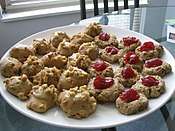 Maple spice cookies and thumbprint cookie
Maple spice cookies and thumbprint cookie- A cookie cake is a large cookie that can be decorated with icing like a cake. This is made by Mrs. Fields
 Hearts shaped Valentine's Day cookies adorned with icing.
Hearts shaped Valentine's Day cookies adorned with icing.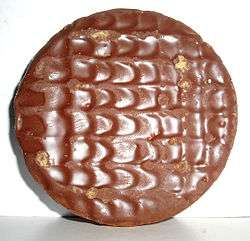
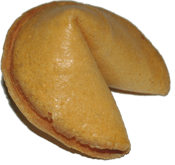 Fortune cookie
Fortune cookie Meringue cookies
Meringue cookies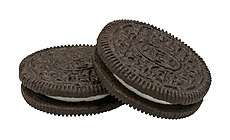 Commercially sold Oreo cookies
Commercially sold Oreo cookies Choc-chip cookies
Choc-chip cookies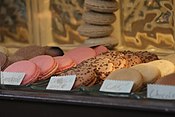 A cookie shop
A cookie shop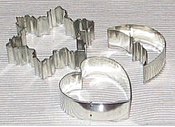 Cookie cutters
Cookie cutters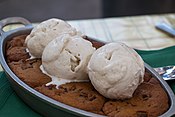 Cookie dessert
Cookie dessert A plate of chocolate chip cookies
A plate of chocolate chip cookies
Related pastries and confections
- Acıbadem kurabiyesi
- Animal crackers
- Berliner (pastry)
- Bun
- Candy
- Cake
- Churro
- Cracker (food)
- Cupcake
- Danish pastry
- Doughnut
- Funnel cake
- Galette
- Graham cracker
- Hershey's Cookies 'n' Creme
- Kit Kat
- Halvah
- Ladyfinger (biscuit)
- Lebkuchen
- Mille-feuille
- Marzipan
- Milk cracker
- Mille-feuille (Napoleon)
- Moon pie
- Nut cluster
- Pastry
- Palmier
- Petit four
- Rum ball
- S'more
- Snack cake
- Tartlet
- Teacake
- Teething biscuit
- Whoopie pie
Manufacturers
- Arnott's Biscuits Holdings (Division of Campbell)
- Bahlsen
- Burton's Foods
- D.F. Stauffer Biscuit Company
- DeBeukelaer
- Famous Amos (Division of Kellogg)
- Fox's Biscuits
- Interbake Foods
- Jules Destrooper
- Keebler
- Lance
- Lotte Confectionery (Division of Lotte)
- Lotus Bakeries
- McKee Foods
- Meiji Seika Kaisha Ltd.
- Mrs. Fields
- Nabisco (Division of Mondelēz International)
- Nestlé
- Northern Foods
- Otis Spunkmeyer (Division of Aryzta)
- Pillsbury (Division of General Mills)
- Pinnacle Foods
- Pepperidge Farm (Division of Campbell Soup Company)
- Royal Dansk (Division of Kelsen Group)
- Sunshine Biscuits (historical)
- United Biscuits
- Walkers Shortbread
- Utz Quality Foods, Inc.
Product lines and brands
- Animal Crackers (Nabisco, Keebler, Cadbury, Bahlsen, others)
- Anna's (Lotus)
- Archway Cookies (Lance)
- Barnum's Animals (Nabisco)
- Betty Crocker (General Mills, cookie mixes)
- Biscoff (Lotus)
- Chips Ahoy! (Nabisco)
- Chips Deluxe (Keebler)
- Danish Butter Cookies (Royal Dansk)
- Duncan Hines (Pinnacle, cookie mixes)
- Famous Amos (Kellogg)
- Fig Newton (Nabisco)
- Fox's Biscuits (Northern)
- Fudge Shoppe (Keebler)
- Girl Scout cookie (Keebler, Interbake)
- Hello Panda (Meiji)
- Hit (Bahlsen)
- Hydrox (Sunshine, discontinued by Keebler)
- Jaffa Cakes (McVitie)
- Jammie Dodgers (United)
- Koala's March (Lotte)
- Leibniz-Keks (Bahlsen)
- Little Debbie (McKee)
- Lorna Doone (Nabisco)
- Maryland Cookies (Burton's)
- McVitie's (United)
- Milano (Pepperidge Farm)
- Nilla Wafers (Nabisco)
- Nutter Butter (Nabisco)
- Oreo (Nabisco)
- Pillsbury (General Mills, cookie mixes)
- Pecan Sandies (Keebler)
- Peek Freans (United)
- Pirouline (DeBeukelaer)
- Stauffer's (Meiji)
- Stella D'Oro (Lance)
- Sunshine (Keebler)
- Teddy Grahams (Nabisco)
- Toll House (Nestle)
- Tim Tam (Arnott's)
- Vienna Fingers (Keebler)
Miscellaneous
- Christmas cookie
- Cookie bouquet
- Cookie cutter
- Cookie dough
- Cookie exchange
- Cookie Clicker
- Cookie Monster
- Cookie sheet
- Cookie table
- Cookies and cream
- Girl Scout cookie
See also
References
- "History of Cookies - Cookie History". Whatscookingamerica.net. Archived from the original on 2008-11-04.
- "Cookies originated from Persia, shortly after the use of sugar became relatively common in the region". The Vintage News. 2016-09-17. Retrieved 2019-11-11.
- Nelson, Libby (29 November 2015). "British desserts, explained for Americans confused by the Great British Baking Show". Vox. Archived from the original on 2 December 2015. Retrieved 2015-12-03.
- Lee, Laura. The Pocket Encyclopedia of Aggravation. New York: Black Dog & Leventhal, 2001.
- "cookie - food". Encyclopædia Britannica. Archived from the original on 2008-02-24.
- "cookie (n.)". etymonline.com. Online Etymology Dictionary. Archived from the original on 1 September 2019. Retrieved 1 September 2019.
- "7 vertalingen voor het dialectwoord 'koekie'". Archived from the original on 2014-09-07.
- Merriam-Webster's Collegiate Dictionary, Tenth Edition. Merriam-Webster, Inc.: 1999.
- Lynne Olver. "The Food Timeline: history notes--cookies, crackers & biscuits". foodtimeline.org. Archived from the original on 2012-07-17.
- "Cookies originated from Persia, shortly after the use of sugar became relatively common in the region". The Vintage News. 2016-09-17. Retrieved 2019-11-11.
- van der Sijs, Nicoline (Sep 15, 2009). Cookies, Coleslaw, and Stoops: The Influence of Dutch on the North American Languages (Paperback ed.). Amsterdam: Amsterdam University Press. p. 125. ISBN 978-9089641243.
- "History of cookies/biscuits". ochef.com. Archived from the original on 2008-03-02. Retrieved 2008-03-01.
- Miller, Jan (2006). Better Homes and Gardens New Cook Book. p. 251. ISBN 9780696224034. Retrieved January 6, 2017.
- Bratskeir, Kate (9 September 2014). "22 Cookies That Are Totally OK To Eat For Breakfast". huffingtonpost.ca. Huffington Post. Archived from the original on 1 September 2019. Retrieved 1 September 2019.
- Insel, Paul; Ross, Don; McMahon, Kimberley; Bernstein, Melissa. Nutrition. Jones & Bartlett Publishers, 2016 p. 335
- Kravitz, Melissa (23 March 2017). "Raw cookie dough is all the rage. But its nutrition facts will make your cookie crumble". mic.com. Mic. Archived from the original on 21 June 2017. Retrieved 1 September 2019.
- "SKILLET CHOCOLATE CHIP COOKIE". canadianliving.com. Canadian Living. October 2018. Archived from the original on 1 September 2019. Retrieved 1 September 2019.
- Ettman, Leah (30 October 2017). "It's hard to believe restaurants sell these supersized cookies". nutritionaction.com. Nutrition Action. Archived from the original on 1 September 2019. Retrieved 1 September 2019.
- Ettman, Leah (30 October 2017). "It's hard to believe restaurants sell these supersized cookies". nutritionaction.com. Nutrition Action. Archived from the original on 1 September 2019. Retrieved 1 September 2019.
- Bratskeir, Kate (9 September 2014). "22 Cookies That Are Totally OK To Eat For Breakfast". huffingtonpost.ca. Huffington Post. Archived from the original on 1 September 2019. Retrieved 1 September 2019.
- Insel, Paul; Ross, Don; McMahon, Kimberley; Bernstein, Melissa. Nutrition. Jones & Bartlett Publishers, 2016 p. 335
- "cookie (n.)". etymonline.com. Online Etymology Dictionary. Archived from the original on 1 September 2019. Retrieved 1 September 2019.
- "cookie (n.)". etymonline.com. Online Etymology Dictionary. Archived from the original on 1 September 2019. Retrieved 1 September 2019.
- Mason, Joanne (28 April 2011). "The Cookie Idioms: Smart Cookie, Tough Cookie". aboutenglishidioms.com. About English Idioms. Archived from the original on 1 September 2019. Retrieved 1 September 2019.
- Partridge, Eric. The Routledge Dictionary of Modern American Slang and Unconventional English. Taylor & Francis, 2009. p. 229.
- Partridge, Eric. The Routledge Dictionary of Modern American Slang and Unconventional English. Taylor & Francis, 2009. p. 229.
- "cookie-cutter". dictionary.com. Dictionary.com. Archived from the original on 1 September 2019. Retrieved 1 September 2019.
- "Cookie Monster curbs cookie habit". BBC News. 2005-04-11. Archived from the original on 2008-03-08. Retrieved 2008-03-02.
- Sesame Street - "The First Time Me Eat Cookie". 7 April 2004. Event occurs at 0:30. Archived from the original on 31 October 2018.
Me was just a mild-mannered little kid. In fact, back then, me think me name was Sid. Yeah, yeah.
- "Cookie Monster: Me wasn't ..." Sesame Street (sesamestreet) on Twitter. 10 August 2010. Archived from the original on 15 April 2016. Retrieved 1 September 2019.
Me wasn’t born with name “Cookie Monster.” It just nickname dat stuck. Me don’t remember me real name… maybe it was Sidney?
- "The Cast of 'Sesame Street' Answer the Web's Most Searched Questions". WIRED Autocomplete interview. 22 February 2017. Event occurs at 7:22.
Is Cookie Monster's real name Sid? Yeah, truly it is. Me real name Sid Monster.
Further reading
- Cumo, C. (2015). Foods that Changed History. ABC-CLIO. pp. 115–117. ISBN 978-1-4408-3537-7.
External links
| Look up cookie or koekje in Wiktionary, the free dictionary. |
| Wikibooks Cookbook has a recipe/module on |